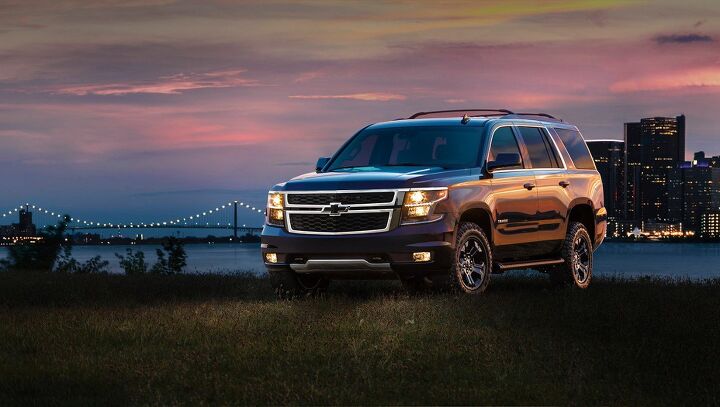Big Incentives and Bursting Inventory Somehow Leads to Record Income for GM

The grim memories of 2008 and 2009 only plague Renaissance Center denizens in the form of night terrors now, as General Motors finds itself on financial ground that’s oddly solid, considering some of the factors effecting the company.
Faced with a slowdown in the automotive market in 2016, the automaker — like so many others —boosted incentives on its vehicles. Meanwhile, the U.S. public’s insatiable thirst for SUVs and crossovers left some of the General’s cars high and dry, sending inventories soaring to very unhealthy levels. While new crossovers were in the pipe in 2016, those lucrative models weren’t scheduled to land until this year. GM’s European division, meanwhile, struggled to rise out of the red.
Despite all of this, the company posted record income and revenue in 2016, according to an earnings report released today.
Last year, GM’s piggy bank saw a record adjusted net income of $12.5 billion, up 15.9 percent from the year before. Net revenue stood at $166.4 billion — 9.2 percent higher than 2015’s tally. Fourth-quarter revenue rose 10.8 percent to $43.9 billion. While foreign currency changes kneecapped Q4 income to $1.8 billion, in line with estimates, it was still up significantly from a year prior.
Global vehicles sales rose 1.2 percent compared to 2015. With such pleasing results, GM’s outlook for 2017 can best be described in one word: rosy.
“By almost any measure, 2016 was a great year for our business and I am confident we can achieve even stronger results,” said GM CEO Mary Barra in a statement.
To keep things rosy, the automaker has had to do some less-than-happy things. Those ballooning inventories led to layoffs at multiple midwestern plants, with extra downtime planned to ease the flow of slower-selling car models. An efficiency program that began in 2015 continued through 2016, freeing up money to firm up the company’s bottom line.
Still, there’s a number of redesigned models arriving in 2017, and luckily for GM, they’re all crossovers. The downsized GMC Terrain and Chevrolet Equinox arrive early this year as 2018 models, while the full-size Chevrolet Traverse and Buick Enclave crossovers are also ready to go.
According to the automaker, “GM expects its global volume from new or refreshed vehicles to grow to 38 percent from 2017-2020, up from 26 percent in the 2011-2016 period. New or refreshed crossovers, trucks and SUVs are expected to represent a majority of this volume between 2017-2020.”
[Image: General Motors]

More by Steph Willems
Latest Car Reviews
Read moreLatest Product Reviews
Read moreRecent Comments
- TheEndlessEnigma These cars were bought and hooned. This is a bomb waiting to go off in an owner's driveway.
- Kwik_Shift_Pro4X Thankfully I don't have to deal with GDI issues in my Frontier. These cleaners should do well for me if I win.
- Theflyersfan Serious answer time...Honda used to stand for excellence in auto engineering. Their first main claim to fame was the CVCC (we don't need a catalytic converter!) engine and it sent from there. Their suspensions, their VTEC engines, slick manual transmissions, even a stowing minivan seat, all theirs. But I think they've been coasting a bit lately. Yes, the Civic Type-R has a powerful small engine, but the Honda of old would have found a way to get more revs out of it and make it feel like an i-VTEC engine of old instead of any old turbo engine that can be found in a multitude of performance small cars. Their 1.5L turbo-4...well...have they ever figured out the oil dilution problems? Very un-Honda-like. Paint issues that still linger. Cheaper feeling interior trim. All things that fly in the face of what Honda once was. The only thing that they seem to have kept have been the sales staff that treat you with utter contempt for daring to walk into their inner sanctum and wanting a deal on something that isn't a bare-bones CR-V. So Honda, beat the rest of your Japanese and Korean rivals, and plug-in hybridize everything. If you want a relatively (in an engineering way) easy way to get ahead of the curve, raise the CAFE score, and have a major point to advertise, and be able to sell to those who can't plug in easily, sell them on something that will get, for example, 35% better mileage, plug in when you get a chance, and drives like a Honda. Bring back some of the engineering skills that Honda once stood for. And then start introducing a portfolio of EVs once people are more comfortable with the idea of plugging in. People seeing that they can easily use an EV for their daily errands with the gas engine never starting will eventually sell them on a future EV because that range anxiety will be lessened. The all EV leap is still a bridge too far, especially as recent sales numbers have shown. Baby steps. That's how you win people over.
- Theflyersfan If this saves (or delays) an expensive carbon brushing off of the valves down the road, I'll take a case. I understand that can be a very expensive bit of scheduled maintenance.
- Zipper69 A Mini should have 2 doors and 4 cylinders and tires the size of dinner plates.All else is puffery.


































Comments
Join the conversation
Why am I seeing the same article at gminsidenews? Is this a new form of corporate synergy?
Wait, you mean their Chinese customers pay MONEY for vehicles?